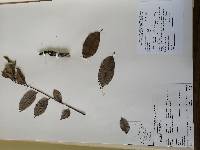
Neotropical Flora
|
Family: Anacardiaceae
|
Tree, mostly 10-30 m tall, to 60 cm dbh; outer bark gray, deeply and coarsely fissured, the raised segments hard, rough, the inner margin irregular; inner bark variously colored, usually with triangular patches of red or tangerine alternating with white; wood soft, white; sap clear, at least never forming viscid droplets; at least the youngest branches puberulent. Leaves imparipinnate, alternate, to 60 cm long (to 70 cm on juveniles); petiole and rachis usually finely puberulent; leaflets mostly (3) 9-17, opposite or subopposite; petiolules 6-9 (14) mm long; blades oblong to ovate, usually acuminate, acute to rounded and asymmetrical at base, 3-20 cm long and 1.5-7 cm wide, usually +/- glabrous but with puberulence on midribs and major veins above and below, minutely revolute with a prominent submarginal vein; midrib of larger leaflets arched., the reticulate veins prominulous. Panicles terminal, to 60 cm long.; branches, peduncles, pedicels, and calyces usually puberulent; pedicels 1-5 mm long, usually articulate near base; flowers 5-7 mm wide, 5-parted, bisexual or rarely pistillate, globular to obovoid in bud; calyx shallow, the lobes short, triangular, sharply acute, usually minutely puberulent, ciliate; petals white, acute and inflexed-apiculate at apex, somewhat reflexed at anthesis; stamens 10, exserted, 1.5-3 mm long, alternating with fleshy, undulate segments of disk; disk fleshy, undulate-lobed, to ca 1 mm. wide, the width of one side less than width of clump of styles; styles usually 4 or 5 (rarely 3), much shorter than stamens at anthesis; stigmas linear, on dorsal surface of style near apex. Fruits oblong to obovoid, 2.5-3 cm long, yellow to orange at maturity; mesocarp, to 6 mm thick, fleshy, sweet and tasty; endocarps obovoid, 2-2.5 cm long, hard, covered by a tough, coarse, fibrous matrix. Croat 10751, 14090. Frequent in the forest. Flowering principally from March to June (rarely earlier), but most abundantly in April and May. The fruits are mature from July to October, mostly in August and September. Leaves fall during the early part of the dry season, beginning in December and January, and grow in again before flowering commences. The species is reportedly dioecious in Mexico (Pennington & Sarukhan, 1968) and monoecious in Costa Rica (Bawa & Opler, 1975). In Panama, flowers are apparently mostly bisexual with some pistillate flowers also. Throughout tropical America; introduced in tropical Africa and East Indies. In Panama, a typical component of tropical moist forest (Tosi, 1971), known principally from the Canal Zone, Bocas del Toro, Colon, Panama, and Darien; known also from tropical dry forest in Coclé. from premontane moist forest in Panama (Farfan Beach), and from premontane wet forest in Chiriqui (Progreso). See Figs. 329 and 330. |
|
|
|
Powered by Symbiota.











































































